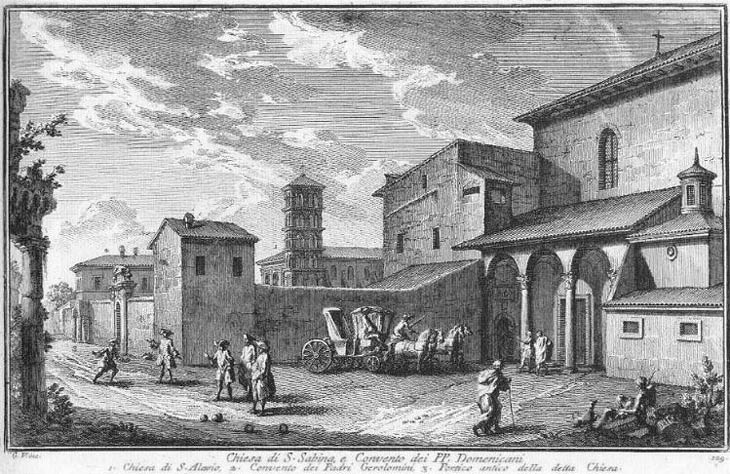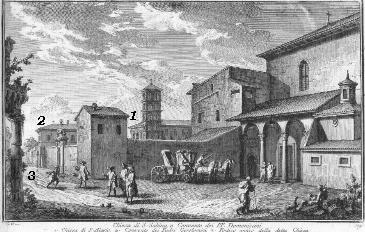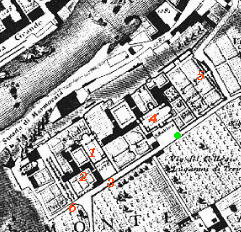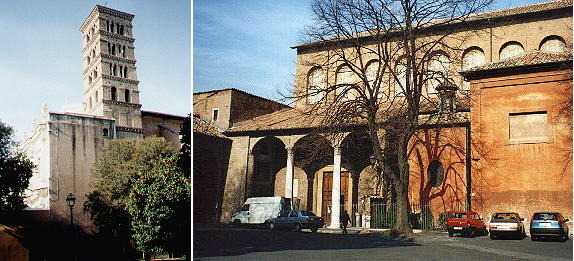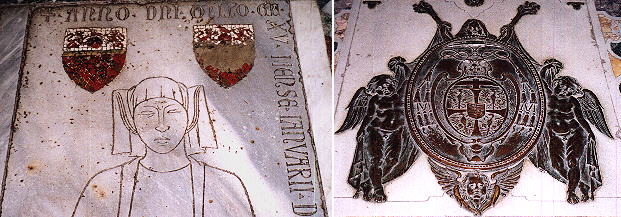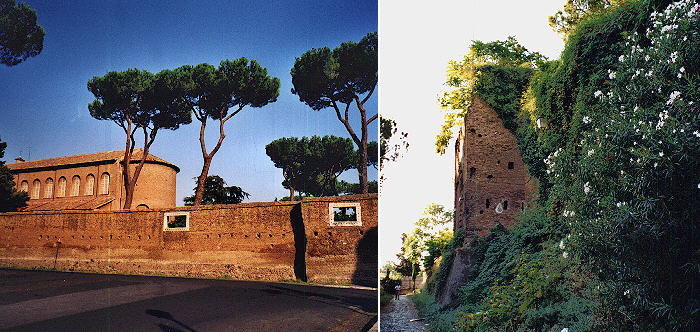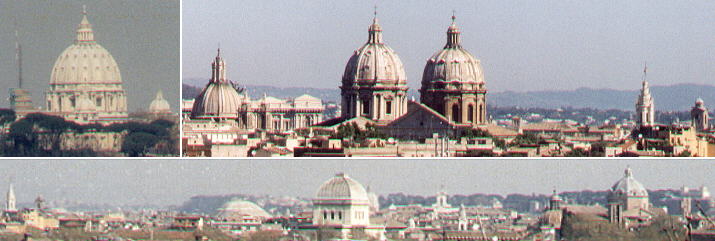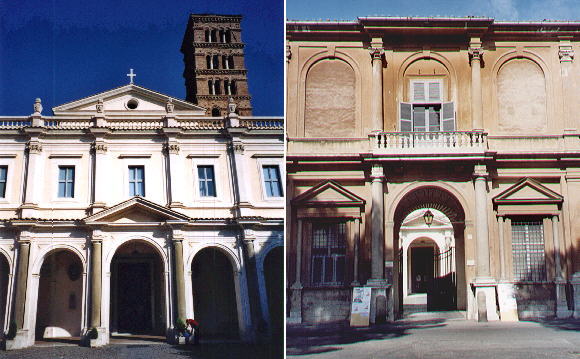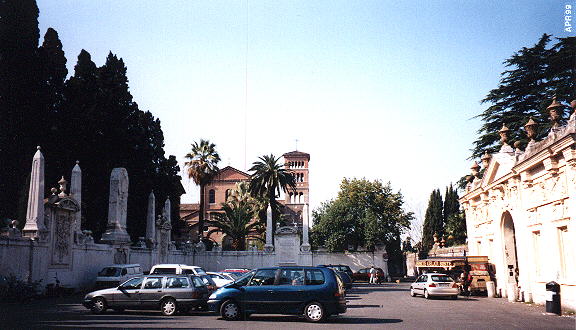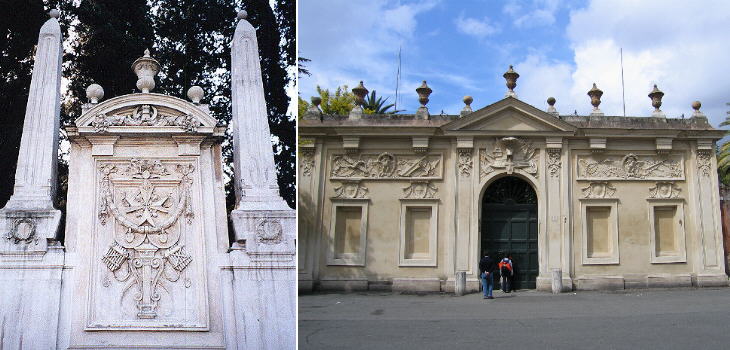

Chiesa di S. Sabina (Book
7) (MapC3) (Day
5) (View C10) (Rione Ripa)
In this page:
The plate by Giuseppe Vasi
Today's view
S. Sabina
Rocca Savella
S. Alessio
The Knights of Malta
The Plate (No. 129)
The churches on the Aventine were very remote from the center of
Rome, with very little traffic in the nearby streets, which as Vasi shows, were used as
bowling alleys. The view is taken from the green dot in the map below. In the description below the plate Vasi made
reference to: 1) S. Alessio; 2) Monastery adjoining the church; 3) Porch of S. Alessio. The small 1748 map
shows also 4) S. Sabina; 5) Rocca Savella; 6) Entrance to the Palace of the Knights of Malta.
Today
An expansion of the monastery of S. Sabina does not allow any longer
the view of both churches.
Read Henry James's account of his visit to this site in 1873.
S. Sabina
S. Sabina dates back to the Vth century: of this period are the wooden panels of the
door, which were reassembled in the XIth century on a new frame decorated with grapes. The panels include
one of the first representations of the Crucifixion. S. Sabina was largely modified by Domenico
Fontana under Sixtus V: these alterations were critically reviewed in the XXth century
to restore the paleochristian aspect of the church including the medieval schola cantorum.
Gravestones in churches often offer a clue to the history of the church itself.
The picture above shows (left) the gravestone of a lady of the Savelli family. Honorius III (Cencio Savelli) and Honorius IV (Jacopo Savelli)
had their court in S. Sabina. The gravestone on the right belongs to a Cardinal Gonzaga, whose
family came from Mantua to Rome in the XVIth century (the Gonzaga were Dukes of Mantua from 1327 to 1707) and built a summer
residence on the slopes of the Aventine towards the river.
Rocca Savella
The Savelli one of the most powerful families in the XIIth - XIIIth centuries made of the
area around S. Sabina a little fortress with walls, towers and a moat. Honorius IV preferred
to hold here the papal court, rather than in the Vatican or in the Lateran. The fortress
was dismantled under Sixtus V to make sure nobody could revive the fights among the
Roman families or against the pope. The walls now protect a garden (giardino degli aranci) named after the orange
trees which were planted here following the example of the orange tree planted here by St Dominic
to whom Honorius III gave the monastery in 1219. The terraces overlooking the river offer great views over Rome.
S. Alessio
S. Alessio was built in the Xth century, but a large modernization completed in 1754 by Tommaso De Marchis left very little
of the original decoration. As in many other baroque alterations of churches, the bell
tower was not touched. Later on the small porch was replaced by a new building.
The Knights
of
Malta
This small piazza was built in 1765 by Giovanni Battista Piranesi
for Cardinal Giovanni Battista Rezzonico, Grand Prior of the Knights of
Malta. Its elaborated decoration is based on themes taken from the coats
of arms of Pope Clemens XIII Rezzonico and of the Knights of Malta. To the right is the entrance
to the palace of the knights called Palazzo Magistrale. The key hole of the door offers a surprising
view of St Peter's dome. In the gardens Piranesi built the little church of S. Maria del Priorato.
Excerpts from Giuseppe Vasi 1761 Itinerary related to this page:
Chiesa e Convento di s. Sabina
Ecco che inavvedutamente ci troviamo sull' alto del monte Aventino, uno de' sette
colli, aggiunto a Roma da Anco Marzio. Prese, secondo alcuni, il suo nome da Aventino
Re di Alba quivi sepolto, o secondo altri ab avibus, che in esso Remo ebbe di augurio;
o pure ab adventu; perchè dal Lazio i popoli solevano quì concorrere all'accennare
tempio di Diana atto da Servio Tullio. Vi abitò il Re Italo, e vi ebbe poi la casa
Vitellio Imperatore, e tanti altri soggetti principali della Repubblica.
La chiesa di s. Sabina fu eretta l’anno 425. sulla casa paterna della medesima
s. Titolare, o come alcuni vogliono, sopra le rovine del divisato tempio
di Diana, da un Prete per nome Pietro di Schiavonia, e perchè s. Gregorio
Magno le concedè la stazione nel primo giorno di quaresima, solevano i Sommi
Pontefici andarvi a dispensare le ceneri, e però vi fu fabbricato un palazzo,
in cui abitarono alcuni Pontefici, e vi furono fatti de' Conclavi. Onorio III.
avendo approvato l'ordine di san Domenico, si concedè questa chiesa,
e parte del palazzo pontificio; ora però que' frati godono tutto.
Questa chiesa è molto grande, e ornata con due ordini di colonne
a guisa di basilica; sotto l'altare maggiore sta il corpo della
s. Titolare, di s. Serapia sua maestra, di s. Evenzio, e di altri
ss. Martiri. Evvi un bel quadro nella cappella a sinistra della
tribuna rappresentante la ss. Vergine con s. Giacinto, ed alcuni
putti per aria, opera di Lavinia Fontana, ed in mezzo alla chiesa si vede un
sasso legato con una catena, che dicesi fosse gettato dal Demonio contro
s. Domenico, mentre di notte faceva orazione in chiesa; ed appresso evvi la
Chiesa e Monastero di s. Alessio
Fu similmente su questo monte il tempio di Ercole detto Aventino, sopra le rovine
del quale si legge, che edificò il suo palazzo Eufemiano Senatore Romano padre di
s. Alessio, sotto le scale del quale visse poi sconosciuto per molti anni il
santo Pellegrino, ed essendovi dipoi eretta la chiesa, vi stettero i monaci di
s. Benedetto, fra' quali in tempo di Giovanni XV. prese l'abito religioso il
vescovo di Praga Adalberto, che poi fu martire di Cristo. Fu una delle 20.
Abazie privilegiate di Roma, e poi succedutivi li monaci Girolamini, nell'anno 1582.
rinnovarono la chiesa; ma ultimamente dal Card. Angelo Quirini titolare della
medesima è stata fatta di nuovo, insieme col monastero. Sotto l'altare maggiore
sono i corpi di s. Bonifazio, di s. Alessio, e di s. Aglae; e
l’immagine della ss. Vergine, che sta nel tabernacolo, fu portata da Edessa di
Soria.
|
Next plate in Book 7: Chiesa di S. Maria del Rosario
Next step in Day 5 itinerary: Veduta
di Ripa Grande
Next step in your tour of Rione Ripa: S. Maria in Cosmedin

Go
to  or to Book
7 or to my Home
Page on Baroque Rome or to my Home Page on Rome
in the footsteps of an XVIIIth century traveller.
or to Book
7 or to my Home
Page on Baroque Rome or to my Home Page on Rome
in the footsteps of an XVIIIth century traveller.
|


